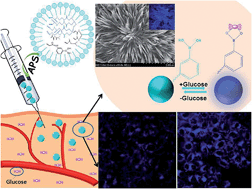Anti-photobleaching flower-like microgels as optical nanobiosensors with high selectivity at physiological conditions for continuous glucose monitoring†
Abstract
Optical glucose detection holds considerable promise for continuous in vivo glucose monitoring with wireless transdermal transmission and long-lasting activity. To construct a new class of optical glucose nanobiosensors with high sensitivity and selectivity at physiological conditions, the first generation of fluorescent poly(amido amine) (G1.0 PAMAM), serving as the optical code, was introduced into glucose-sensitive poly(N-isopropylacrylamide-(2-dimethylamino)ethyl methacrylate-3-acrylamidephenylboronic acid) copolymer microgels via a facile method. The fabricated microgels display the ability of adapting to the surrounding medium of different glucose concentrations over a clinically relevant range (0–20 mM) and convert biochemical signals into optical signals. As nanobiosensors, the G1.0 PAMAM functionalized microgels exhibit high selectivity for glucose over various kinds of potential primary interferents, such as lactate, human serum albumin and metal ions, in the physiologically important glucose concentration range. Compared to traditional fluorescent dyes and quantum dots, which are limited by photobleaching and toxicity, this microgel with remarkable anti-photobleaching property and low toxicity makes it possible to be used for long-term continuous glucose monitoring. Through in vivo investigations, it can be observed that G1.0 PAMAM functionalized microgels can achieve wireless transdermal detection, indicating that the fabricated microgels have potential applications as a new generation of nanobiosensors for the highly sensitive and minimally invasive continuous glucose monitoring.


 Please wait while we load your content...
Please wait while we load your content...